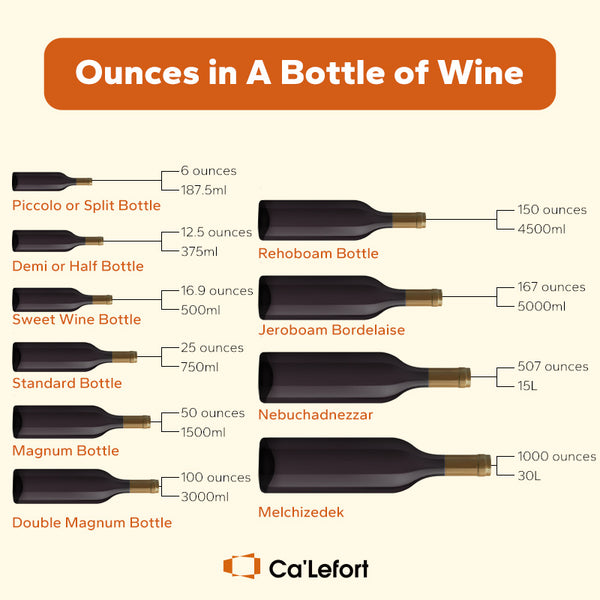Wine has long been celebrated for its ability to accompany meals, enhance celebrations, or simply offer a delightful escape at the end of a long day. Whether you're a wine connoisseur or an occasional indulger, understanding the fundamentals of wine, such as the ounces in a bottle, is essential for making informed choices!
Standard Wine Bottle Capacity
The standard 750 milliliters bottle size is most popular in the United States. This is equal to about 25.4 fluid ounces. This number is now the gold standard for all winemakers around the world. It is very important to know this base volume because it is used as a standard for other bottle sizes. It's important to remember, though, that the US isn't the only country that makes wine, and that different parts of the world have their own bottle sizes. In the U.S., a 750-milliliter bottle is standard. In France and Italy, on the other hand, people often choose this size or the slightly bigger 1-liter bottles. The main thing to remember is that this standard bottle size is a good starting point.
Variations in Wine Bottle Capacity by Type
While a standard wine bottle typically holds 750ml (25 fluid ounces), the world of wine offers a plethora of bottle sizes to suit diverse occasions and preferences. Let's explore these sizes and how many glasses of wine you can pour from each, assuming a standard 5-ounce pour.

1. Piccolo or Split Bottle (187.5ml)
The Piccolo or Split Bottle is a small choice. It holds 187.5ml, which is a little more than 6 ounces of liquid. These tiny bottles are often found with Champagne for one person. They're great for a big glass of sparkling wine by itself.
2. Demi or Half Bottle (375ml)
The Demi, or Half Bottle, is exactly half the size of a regular bottle. It can hold 375ml, which is a little more than 12.5 ounces of liquid. A normal 5-ounce pour will get you about 2.5 glasses of wine from this bottle.
3. Sweet Wine Bottles (500ml)
You might find smaller bottle sizes, like 500ml, for sweet wines like dessert or late harvest wines. The strong tastes of these wines are meant to fit in these bottles, which usually hold about 2.5 glasses.
4. Standard Bottle (750ml)
The most popular size is the standard bottle, which holds 750ml, or 25 ounces of liquid. It makes about 5 glasses of wine, so it's good for most situations, like having dinner with friends or having a quiet night in.
5. Magnum Bottle (1.5L)
One Magnum Bottle holds 1.5 liters, which is 50 ounces. It is twice as big as a regular bottle. You can pour about 10 glasses of wine from a Magnum, which makes it a great choice for big parties or events that last a long time.
6. Double Magnum Bottle (3L)
The Double Magnum is twice as big as a Magnum and can hold a large 3 liters, which is about 100 ounces. You can pour about 20 glasses of wine from this bottle, which makes it a great choice for big events and parties. Box wine is interesting because it usually comes in 3-liter bottles, which are the same size as a standard 5-ounce pour and hold the same number of drinks.
7. Rehoboam (4.5L)
The Rehoboam is bigger than the double magnum. It can hold 4.5 liters, which is about 150 ounces. This huge bottle holds about 30 glasses of wine and is usually only used for very important events.
8. Jeroboam Bordelaise (5L)
The Jeroboam Bordelaise is even bigger. It can hold 5 liters, which is 167 ounces of liquid. You can pour about 33 glasses of wine from this huge bottle, which makes it a great choice for big parties and meetings.
9. Nebuchadnezzar (15L)
The Nebuchadnezzar really stands out because it holds 15 liters, which is about 500 ounces, of wine. This huge bottle of wine makes about 100 glasses, and it's usually saved for the biggest parties or as a collector's item.
10. Melchizedek (30L)
There are 30 liters, or about 1,000 fluid ounces, of wine in the Melchizedek, which is the biggest wine bottle. This beautiful bottle holds about 200 glasses of wine and is very rare. You can usually only see it in high-class wine stores or at fancy events.
How to Calculate Ounces in a Wine Bottle
There is an easy way to find out how many ounces are in a normal 750-milliliter wine bottle: A milliliter is about the same as 0.0338 fluid ounces. You can increase 750 by 0.0338 to get about 25.35 fluid ounces, which is the size of a 750-milliliter bottle. There is, however, a standard that is often rounded up to 25.4 fluid ounces for ease of use. This is the number that is often used on wine labels.
Milliliter to Ounces Converter
Although each wine bottle has a different volume, you can still use the same math to figure out how many ounces it holds. One-liter bottles, for example, hold about 33.8 ounces of liquid (1000 milliliters times 0.0338). If you want to compare the sizes and contents of different wine bottles, this easy math can help.
Different Shapes of Wine Bottles and Their Ounces
1. Bordeaux Bottles
Bordeaux bottles are known for their straight sides and high shoulders. These bottles typically have a capacity of 750 milliliters, which is approximately 25.4 fluid ounces. A lot of red wines, like Cabernet Sauvignon, Merlot, and others, go in them. The way Bordeaux bottles are made keeps the wine from getting too much air, which helps it age properly.
2. Burgundy Bottles
When compared to Bordeaux bottles, Burgundy bottles have shoulders that slope down and a bigger body. They can hold 750 milliliters as well, but the form works better for Pinot Noir and Chardonnay. The wider bowl gives these wines room to breathe, and the form goes well with their light scents.
3. Champagne Bottles
The thicker glass and deep punt (the depression in the bottom) of champagne bottles make them stand out. The pressure of sparkling drinks is strong enough to break these bottles. A typical Champagne bottle, like a Bordeaux bottle, holds 750 milliliters. Magnum Champagne bottles, which hold 1.5 liters, are popular for bigger events.
4. Rhône Bottles
Rhône bottles, which are often used for wines from the Rhône Valley, have shoulders that slope down and a shape that looks like a mix of Bordeaux and Burgundy styles. These bottles can hold a lot of different types of wine because they can hold 750 milliliters.
5. Large Format Bottles
Larger bottles are used for special events, by fans, and to age wine. Larger forms, like Magnums (1.5 liters), Jeroboams (3 liters), and even bigger ones, look great and help wines age well by reducing their exposure to oxygen.
How Many Ounces in a Wine Glass
1. Standard Red Wine Glass (12-14 ounces)
Standard red wine glasses typically have a capacity of 12 to 14 ounces. Because these cups have a bigger bowl, red wines can breathe and develop their complex bouquet. This shape makes it easier to swirl the wine and smell the different flavors, which makes it perfect for Cabernet Sauvignon and Merlot.
2. Standard White Wine Glass (8-12 ounces)
White wine glasses tend to be slightly smaller, with capacities ranging from 8 to 12 ounces. The narrower bowl focuses the wine's delicate aromas, making it perfect for Chardonnay, Sauvignon Blanc, and other white wine varietals.
3. Sparkling Wine Flute (6-10 ounces)
Flute glasses, designed for sparkling wines like Champagne and Prosecco, are tall and narrow, with capacities typically ranging from 6 to 10 ounces. The form helps keep the wine's fizz and pushes the bubbles to the top, which makes the experience better both visually and olfactorily.
4. Dessert Wine Glass (3-5 ounces)
Dessert wine glasses are much smaller, usually holding 3 to 5 ounces. You can sip sweet and spiced wines like Port, Sherry, and Sauternes from this small glass. The stronger tastes of these wines go well with the smaller glass size.
5. Universal Wine Glass (12-16 ounces)
If you're looking for a versatile option, a universal wine glass with a capacity of 12 to 16 ounces is a great choice. It can accommodate a wide range of wine styles and varietals, making it a convenient option for casual wine drinkers.

The Standard Pour of Wine
1. Restaurants and Bars
In most American restaurants and bars, the standard pour of wine is typically 5 to 6 ounces. This pour size was set so that customers can get a fair and regular amount of wine. It gives the drinker just the right amount of wine to enjoy and judge based on its smells, tastes, and personality. This part is also in line with responsible alcohol service, so people can drink a modest amount of wine here.
2. Tastings and Wine Events
At wine tastings and events, you'll often encounter smaller pours, typically around 2 to 3 ounces. This pour size is meant to let people try a variety of wines without drinking too much. It's great for trying a bunch of different wines and reviewing how they taste.
3. At Home
The pour size for wine served at home can change based on the type of wine and the person's taste. A good rule of thumb, though, is to stick to the 5–6-ounce rule that places usually use. It gives you a balanced dose that lets you fully enjoy the subtleties of the wine.
It's important to remember that the standard pour is meant to show off the wine's best qualities and make the experience pleasant. If you pour too little, you might not be able to fully enjoy the wine, and if you pour too much, you might waste it or drink too much. The usual pour of 5 to 6 ounces is a good size.
FAQs
1. Why Do Wine Bottles Vary in Size?
There are many reasons why wine bottle sizes can be different, such as regional preferences, cultural customs, and the type of wine. Knowing about these differences can help you enjoy how different the wine world is.
2. Is the Ounce Measurement on the Label Always Accurate?
The number of ounces on a wine label is usually rounded to make things easier. Even though it's a good guess, the exact size might not always match because of how numbers are rounded. The number is not an exact figure; it's just a rough estimate.
3. Does the Bottle Shape Affect the Wine's Flavor?
Some wine lovers think that the shape of the bottle can change the taste of the wine. It's important to think about how wine is stored and aged, even though it's a controversial subject, because the touch between wine and air in the bottle can change the taste in small ways.
4. Are Smaller Bottles Always More Expensive?
Smaller bottles, like half-bottles that hold 375 milliliters, don't always cost less. So much so that they are sometimes more expensive per ounce than regular bottles. People in niche markets and collectors may be interested in the smaller version.









